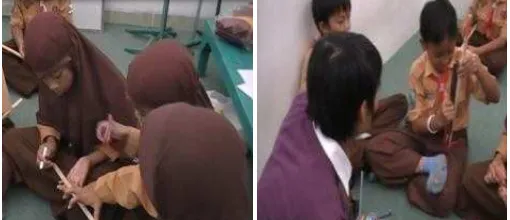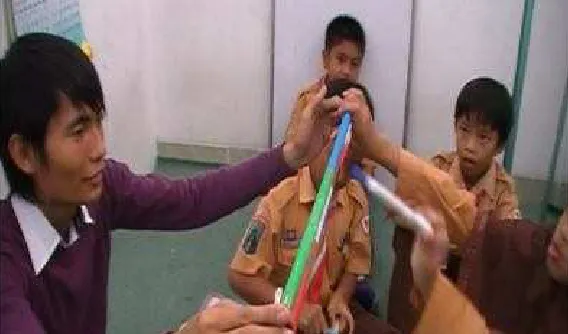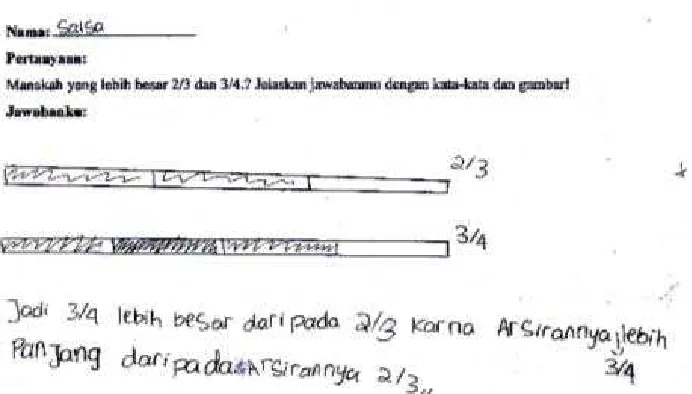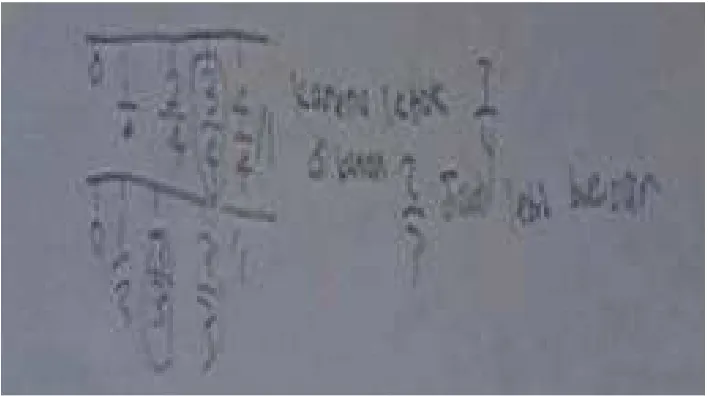M – 34
previous researcher confirmed that the problem which students encounter in learning fraction operations is not firmly connected to concrete experiences. Primary school curricula in Indonesia introduce fractions in class III and by class V, students are expected to learn many operastions on fractions. In fact, many students in class V have some misconceptions or misunderstandings about the concepts. For instance, they would say that ¼ is more than 1/3 and ½ + 2/3 = 3/5. In addition, most textbooks used by students contain basically many procedures, they learn fractions mechanically without any conceptual grasp. Moreover the textbooks use only part-whole interpretation as a way to introduce a fractions, it is not enough in facilitating students’ reasoning in the context of task of comparing, finding equivalent fractions and operating fractions. In this paper, we describe data/informations colected during facilitating student in learning fractions using methode combining the part-whole and measure interpretation of fractions. We also will show examples of students’ reasoning indicating teaching fractions using the combination migh prove to be better methode in supporting students’ reasoning about fractions.Key words: reasoning, fractions, part-whole, measure
INTRODUCTION
Many researchs confirmed that a fractions has been described as being interpreted with five views: part-whole, measure, ratio, operator and quotient (Behr, Harel, Post, & Lesh, 1993; Carraher, 1996; Kieren, 1988; Lamon, 2001). Eventhough part-whole interpretation is the most widely adopted view for the learner to start with, the part-whole view has been described as “the least valuable road into the system of rational numbers” (Lamon, 2001, p.163). So is there another, simpler way to think about fractions?
As part-whole interpretation, fractions can also be thought of as parts of objects or collections: one-half of a donnut, five-quarters of a pizza or one-third of a bag of candies.
Alternatively, fractions can be thought of as numbers:
1 5
,
2 4
or3
, it does not make sense to suggest that half of a donnut is greater than one-third of a bag of candies. Usually, teacher introduces notation of fractions as a methode of recording a double count parts of fractions such as counting the number of parts shaded, counting the total number of parts and then writing the first count over the second count as a representation of a fractions. To Introduce the notation of fractions teacher needs to pay attention to the whole. Teacher can introduce fractions from the viewpoint of measuring quantities, and focus initially on the dimension of length.between informal understandings and more formal mathematical ideas. However, to explore how students build upon their informal knowledge to improve their understanding of fractions, we need to do research to describe it. The research includes focusing on which activities can be used in instruction in order to make fractions more meaningful for children. Mack (1999) proposed an activity using the term ‘partitioning’ to cover part-whole.
In this paper we focus on whether the interpretation of fractions in which the concept of fractions is used supports student’s reasoning to understand fractions. The study was carried out with third-grade pupils who had not been taught about fractions in school. There are two specific questions were investigated. First, How do children learn to represent fractions with numbers in part-whole and measure situations? Second, How do children understand the equivalence and ordering of fractions?
RESEARCH METHOD
The method used in this research is called design research. It is a type of research methods with its core of research is formed by classroom teaching experiments that center on the development of instructional sequences and the local instructional theories that underpin them (Gravemeijer, 1994).
In this design research, there are three phases: developing a preliminary design, conducting a teaching experiment, and carrying out a retrospective analysis (Gravemeijer, 1994; Bakker, 2004). Each of these forms a cyclic process both on its own and in a whole design research. Therefore the design experiment consists of cyclic processes of thought experiments and instruction experiments (Freudenthal, 1991).
Defining a Hypothetical Learning Trajectory (HLT) is needed before elucidating of these three phases. HLT is a design and research instrument that proved useful during all phases of design research (Bakker: 2004).
During the preliminary design, HLT guides the design of instructional materials that have to be developed or adapted. During teaching experiment, the HLT functions as a guideline for the teacher and researcher what to focus on in teaching, interviewing, and observing. And during the retrospective analysis, HLT functions as guideline determining what the researcher should focus on in the analysis (Bakker, 2004).
The following sections, we discuss the three phases of the design research according to Gravemeijer (1994), Bakker (2004), and Gravemeijer and Cobb (2006).
Phase 1: Preparation and Design
In this phase, we construct the Hypothetical Learning Trajectory (HLT) that developed potential sequence activities concerning the goal of the research. This HLT is called HLT I. In constructing this HLT, we explore and study prior research on fractions, elaborate with phenomenology related to fractions and also discuss with supervisor and expert.
Phase 2: Teaching Experiment
In our plan, teaching experiment will conduct in two phases, namely pilot experiment and teaching experiment. The purpose of pilot experiment are (1) investigating pre-knowledge of students, because it is important for the starting point of the instructional activities and adjusting the initial HLT, (2) adjusting the HLT I, the HLT I is tried out and the observed actual learning process of students is employed to make adjustments of the HLT.
The teaching experiment aims at collecting data for answering the research questions. During the teaching experiments, we emphasize the ideas and conjectures could be modified while interpreting students’ reasoning and learning in the classroom. The teaching experiments are conducted in six lessons in which the duration was 70 minutes for each lesson. Before doing teaching experiment, teacher and researcher discussed the upcoming activity.
Phase 3: Retrospective Analysis
RESULT AND DISCUSSION
In this part, we will describe some examples showing how students interprete and compare fractions by using part-whole and measure meanings. At the first activity, students were asked to partition a stick through the process of measuring the length. We found that students had a good measurement capabilities, including using standard measurement units or non-standard, such as inches / hand spam.
Figure 1. Students measured and partitioned a stick by using ruler and their fingers
Baturo (2001) suggested that if the teacher want to introduce fractions as part-whole meaning, the partitioning scheme have been put forward. In particular, students have to understand that the parts into which the whole is partitioned should be of equals to. They must also be able to partition a continous area/length or discrete set into equal parts and discern whether the whole has been partitioned in equal parts.
The next activity, students were asked to determine the length of each part of the partitioned stick. In doing this, student used the part-whole meaning to represent length of the parts. Consider the following transcript:
Researchers : Consider this stick. How long this part? (Pointing to the middle mark of the stick) Salsa : half
Ayu : one over two Researcher : why?
Salsa : because in the middle of the stick
Researcher : How about this (pointing to the fourth stick)? Ayu : quarter
Salsa : yes ... one over four Researcher : why?
Ayu : because there are four parts Researcher : there are others, Salsa?
Salsa : ¼ because there are 4 parts (pointing to all the parts) and this is one (pointing to the first part)
Researcher : What about this part? (Pointing to the two parts of a stick) Ayu : 2 / 4
Researcher : why?
Salsa : 2/4 because there are 4 parts (pointing to all the parts) and there are the two parts (pointing first part)
When salsa said that “¼ because there are 4 parts and this is one” as a supporting idea to explain the meaning of ¼, it can be concluded that she interpreted the fractions as part-whole.
Lamon (1999) stated that the part-whole meaning of fractions is defined as a situation in which a continuous quantity or a set of discrete objects are partitioned into parts of equal size. Thus, the fractions means a comparison between the number of parts of the partitioned unit to the total number of parts in which the unit partitioned. Consequently, the numerator of the fractions must be less or equal to the denominator.
Researcher : Ayu, how long from this to this (pointing to the tip and base of the first part of the stick is divided into four parts)
Ayu : 15 cm (he used a ruler to measure) Researcher : any other opinion!
Ayu : ooh….¼
Researcher : Salsa, how long from this to this (pointing to the end of the first and second base parts of the stick is divided into four parts)
Salsa : 2 / 4
Salma : Salma, from this to this? (Referring to the end of the first and the end of the third part of the partitioned stick)
Researcher : So, what do you know about ¾?
Salma : distance from this to this (pointing to the base of the first part and the end of the third parts of the partitioned stick)
Researcher : how many ¼ in 3/4 ? Salma : there are 3 of ¼ .
Researchers : so, what do you know about 6/4 Salma ...? Salsa : ehmmm….the length of stick consisting of 6 of ¼
When salsa said that a quarter is the length of a part of the partitioned stick which is divided into four equal parts. Likewise, Salma said that 6/4 is the length of stick consisting of 6 of 1/4. It can be concluded that the students interpreted the fraction as a measure meaning.
As the measure interpretation, a fraction is associated with two closely interrelated and interdependent notions. First, it is considered a number, which conveys the quantitative personality of fractions, viz., how big the fraction is. Secondly, it is associated with the measure assigned to some interval. More specifically, a unit fraction is defined (i.e., 1/a) and used repeatedly to determine a distance from a preset starting point (Lamon, 2001). For example, 3/4 corresponds to the distance of 3 (1/4-units) from a given point. No wonder why this latter personality of fractions has systematically been associated with using number lines or other measuring devices (e.g., rulers) to determine the distance from one point to another in terms of 1/a-units.
To introduce the idea of comparation and equivalent teacher asked students to compare the length of parts of the colored/partitioned sticks. In this activity, we found that students also expressed about the idea of equivalence of fractions. Consider the following picture and transcript of the conversation:
Figure 2. Discussion among teacher and students about the equivalence of fractions
Researcher : Now, let’s see two sticks (holding the stick partitioned into 2, 4 and 6 parts). How do you think?
Ayu : This is the same with this (pointing to the first part of the first stick which is divided into 2 and pointed to the second part of the two sticks that are divided into 4)
Researcher : So, what does it mean? Ayu : half equals two quarters. Researcher : Are you sure?
Ayu : ehm (smiling) ... .. yup, because the distance is same. Researcher : No more?
Salsa : half equals two quarters and three over six. Researcher : why?
Salsa : because they are the same length
This showed that comparing the parts of the partitioned stick supports students to employ a strategy to compare fractions that is comparing the length of parts of partitioned stick that represent the fractions. Another stimulus created by the teacher in the class was by possing problem about ordering/sorting fractions ( smallest to biggest). This problem was used by teacher to support emergence model of as representation of fractions.
Teacher : how to compare two fractions, 2/3 and ¾? Salsa : may I make draw?
Teacher : of course…how do you compare them?
Salsa : I compare the length of the shading (she make two bar, she divide the first into three parts and draw two parts of the bar with parallel or crossing line for effect (shadow) and she also divide the second one into 4 parts and draw three parts of stick with parallel or crossing line for effect (shadow))
Teacher : based on your picture, which one the bigger one? 2/3 or ¾? Salsa : ¾
Teacher : why? can you explain?
Salsa : because this shading (point to the bar divided into 4 parts) is longer than this (point to the bar divided into 3parts).
Teacher : so, how do you compare them? Salsa : by comparing the length of them
Figure 3. Salsa’s strategy in comparing fractions
that the need of representation of fractions has commenced to compare fractions by comparing the length of shaded parts that represent the fractions. The phrase “by comparing the length of them” as the answer of “how do you compare them?” showed that students commence to use comparing/measurement length of shaded part as strategy to compare fractions. This also showed that comparing/measuring shaded parts that represents the fractions support students’
reasoning in thinking.
In the class presentation, reasearcher found another model of situation used by student to compare fractions. Consider the following student’s work and transcript:
Figure 4. Ayu’s work in comparing 2/3 and ¾
Teacher : can you explain your answer? Why ¾ is bigger than 2/3? Ayu : because the position of ¾ is right side of 2/3
Teacher : so, do you means if the fractions is on the right side of the other fractions, it is bigger than the fractions on left side
Ayu : yup…. The right position of fractions, the greater that fractions
Ayu used a draw, line, as representation of fractions to compare fractions. The drawing showed that students commence to use number line as model of situation/problem to compare the fractions. The phrase” because the position of ¾ is right side of 2/3” as answer of “Why ¾
is bigger than 2/3?” showed that Ayu realize that every number stated on the right side is more
than the number on the lift side. It means that she knew how to compare fractions by using
number line as a model i.e. by comparing the position of number on the number line.
CONCLUSION AND SUGGESTION
We found that the combining part-whole and measure meanings could support students to relate to fractions symbol meaningfully and to employ some of ways to compare fractions. To introduce the idea of part-whole meaning teacher should provide student to master partition skill. The partition activity will guide students to realise in that the fractions means a comparison between the number of parts of the partitioned unit to the total number of parts in which the unit partitioned. Then, by comparing the length of the parts of partitioned stick activity students commenced to realise that a fraction is associated with two closely interrelated and interdependent notions. First, it is considered a number, which conveys the quantitative personality of fractions, how big the fraction is. Secondly, it is associated with the measure assigned to some interval. Students also came up a model of situation (situtional model), number line and bar model, to compare fractions.
REFERENCES
Bakker, A. (2004). Design Research in Statistics Education: On Symbolizing and Computer
Tools. Utrecht: CD-β Press.
Ball, D. (1993). Halves, pieces and twoths: constructing and using representational contexts in teaching fractions. In T.P. Carpenter & E. Fennema & T. A. Romberg (Eds.), Rational
Numbers: An Integration of Research (pp.49-84). Hillsdale, NJ: Lawrence Erlbaum
Associates.
Baturo, A.R. (2004). Empowering Andrea to help year 5 students construct fraction understanding, Proceedings of the 28th PME Conference, Vol. 2, Bergen University College, Bergen, pp. 95–102.
Behr, M.J., Harel, G., Post, T. and Lesh, R.: 1993, ‘Rational numbers: Toward a semantic analysis-emphasis on the operator construct’, in T.P. Carpenter, E. Fennema and T.A.
Cobb, Paul & Gravemeijer, Koeno. (2006) Educational Design Research, London & New York: Routledge (Taylor & Francis group).
Freudenthal H. (1991). Revisiting Mathematics Education: China Lectures. Dordrecht, The Netherlands: Kluwer Academics Publisher
Gravemeijer, Koeno. (1994). Developing Realistic Mathematics Education, The Netherlands:
CD-β Press, 1994.
Hannula, M.S.: 2003, ‘Locating fraction on a number line’, in N.A. Pateman, B.J. Dougherty and J. Zilliox (eds.), Proceedings of the 2003 Joint Meeting of the PME and P MENA,
Vol. 3, CRDG, College of Education, University of Hawaii, Hawaii, pp. 17–24.
Kieren, T. (1988). Personal knowledge of rational Numbers: Its intuitive and formal development. In J. Hiebert & M. Behr (Eds.), Number concepts and operations in
middle-grades (pp.53-92). Reston, VA: National Council of Teachers of Mathematics.
Cuoco and F. Curcio (eds.), The Roles of Representations in School Mathematics-2001
Yearbook, Reston: NCTM, pp. 146–165.
Lamon, S.J.: 1999, Teaching Fractions and Ratios for Understanding, Lawrence Erlbaum Associates, New Jersey.
Mack, N. (1990). Learning Fractions with Understanding: Building on informal knowledge.
Journal for Research in Mathematics Education, 21, 16-32.



